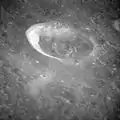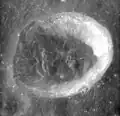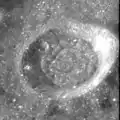Pannekoek (crater)
Pannekoek is a lunar impact crater that is situated on the far side of the Moon, and cannot be seen directly from the Earth. The crater lies along the northern edge of the slightly larger Dellinger, and their common border forms an area of uneven terrain. Due north of Pannekoek is the huge walled plain Mendeleev. Glazenap crater is to the northwest.
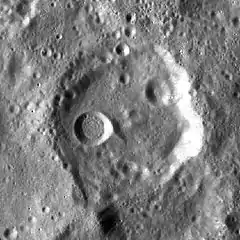 LRO image | |
| Coordinates | 4.20°S 140.69°E |
|---|---|
| Diameter | 67.5 km |
| Depth | Unknown |
| Colongitude | 220° at sunrise |
| Eponym | Anton Pannekoek |
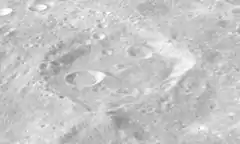
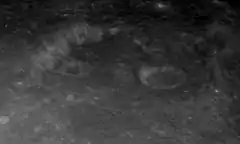
.jpg.webp)
The crater was named after Dutch astronomer and father of Council Communism, Antonie Pannekoek by the IAU in 1970.[1] The crater was known as Crater 292 prior to naming.[2]
This is a worn and eroded crater, although the perimeter of the rim is still visible. The southern part of the interior floor is jumbled and irregular. There is a small crater next to the inner wall along the west-southwest part of the floor. A smaller crater also lies in the interior along the northeast inner wall. There are also several small craterlets on the floor.
Satellite craters
By convention, these features are identified on lunar maps by placing the letter on the side of the crater midpoint that is closest to Pannekoek.
Pannekoek S is similar to a few other far-side craters like Mandel'shtam Q and Barbier F that have hummocky floors.
| Pannekoek | Latitude | Longitude | Diameter |
|---|---|---|---|
| A | 0.9° S | 141.0° E | 28 km |
| D | 2.6° S | 143.5° E | 28 km |
| R | 5.4° S | 138.3° E | 71 km |
| S | 4.4° S | 140.1° E | 18 km |
| T | 4.1° S | 138.2° E | 25 km |
References
- Pannekoek, Gazetteer of Planetary Nomenclature, International Astronomical Union (IAU) Working Group for Planetary System Nomenclature (WGPSN)
- Lunar Farside Chart (LFC-1A)
- Andersson, L. E.; Whitaker, E. A. (1982). NASA Catalogue of Lunar Nomenclature. NASA RP-1097.
- Blue, Jennifer (July 25, 2007). "Gazetteer of Planetary Nomenclature". USGS. Retrieved 2007-08-05.
- Bussey, B.; Spudis, P. (2004). The Clementine Atlas of the Moon. New York: Cambridge University Press. ISBN 978-0-521-81528-4.
- Cocks, Elijah E.; Cocks, Josiah C. (1995). Who's Who on the Moon: A Biographical Dictionary of Lunar Nomenclature. Tudor Publishers. ISBN 978-0-936389-27-1.
- McDowell, Jonathan (July 15, 2007). "Lunar Nomenclature". Jonathan's Space Report. Retrieved 2007-10-24.
- Menzel, D. H.; Minnaert, M.; Levin, B.; Dollfus, A.; Bell, B. (1971). "Report on Lunar Nomenclature by the Working Group of Commission 17 of the IAU". Space Science Reviews. 12 (2): 136–186. Bibcode:1971SSRv...12..136M. doi:10.1007/BF00171763. S2CID 122125855.
- Moore, Patrick (2001). On the Moon. Sterling Publishing Co. ISBN 978-0-304-35469-6.
- Price, Fred W. (1988). The Moon Observer's Handbook. Cambridge University Press. ISBN 978-0-521-33500-3.
- Rükl, Antonín (1990). Atlas of the Moon. Kalmbach Books. ISBN 978-0-913135-17-4.
- Webb, Rev. T. W. (1962). Celestial Objects for Common Telescopes (6th revised ed.). Dover. ISBN 978-0-486-20917-3.
- Whitaker, Ewen A. (1999). Mapping and Naming the Moon. Cambridge University Press. ISBN 978-0-521-62248-6.
- Wlasuk, Peter T. (2000). Observing the Moon. Springer. ISBN 978-1-85233-193-1.


